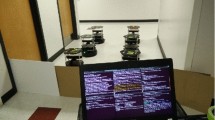Abstract
Dependence on a team of robots to carry out the exploration missions has many benefits such as speeding up the missions; provided that the coordination among robots is maintained. Many circumstances can limit the communication, which is crucial for the coordination among robots (e.g. impenetrable barriers, high temperature etc.). A periodic rendezvous strategy is considered in this paper as a work around in order to overlap communication ranges of the robots. Attending these periodic rendezvous sessions requires that the robots interrupt their current exploration progress periodically and traverse back to the rendezvous points (i.e. Interruptibility). During their trips to these points, they do not gain new knowledge since they cross already explored parts of the area. Therefore, using rendezvous strategies improves the team behavior but has a negative impact on the time efficiency. The contribution of this paper is to mitigate this negative impact of Interruptibility on explorations while maintaining the coordination among robots. The mitigation algorithm is evaluated on several graphs and its performance is compared with other rendezvous approaches where the results are promising.
Access this chapter
Tax calculation will be finalised at checkout
Purchases are for personal use only
Similar content being viewed by others
References
Wallgrün, Jan Oliver. 2010. Hierarchical Voronoi graphs - Spatial representation and reasoning for mobile robots. Berlin/Heidelberg: Springer.
Fazli, Pooyan. 2010. On Multi-robot Area Coverage. In Advances in artificial intelligence, ed. Atefeh Farzindar and Vlado Kešelj. Lecture Notes in Computer Science, vol. 6085, 384–387. Berlin/Heidelberg: Springer.
Thrun, Sebastian, Scott Thayer, William Whittaker, Christopher Baker, Wolfram Burgard, David Ferguson, Dirk Hahnel, Michael Montemerlo, Aaron Morris, Zachary Omohundro, Charlie Reverte, and Warren Whittaker. 2004. Autonomous exploration and mapping of abandoned mines. IEEE Robotics Automation Magazine 11 (4): 79–91.
Murphy, Robin R., Satoshi Tadokoro, Daniele Nardi, Adam Jacoff, Paolo Fiorini, Howie Choset, and Aydan M. Erkmen. 2008. Search and rescue robotics. In Springer handbook of robotics, ed. Bruno Siciliano and Oussama Khatib, 1151–1173. Berlin/Heidelberg: Springer.
Nakatani, Ichiro. 2002. Robotics for planetary exploration. The Japan Society of Mechanical Engineers 13 (2).
Parker, Lynne E. 2008. Multiple mobile robot systems. In Springer handbook of robotics, ed. Bruno Siciliano and Oussama Khatib, 921–941. Berlin/Heidelberg: Springer.
Nelson, Bradley J., Lixin Dong, and Fumihito Arai. 2008. Micro/nanorobots. In Springer handbook of robotics, ed. Bruno Siciliano and Oussama Khatib, 411–450. Berlin/Heidelberg: Springer.
Zhao, Jie, Gang Liu, Yubin Liu, and Yanhe Zhu. 2008. Research on the Application of a Marsupial Robot for Coal Mine Rescue. In Intelligent Robotics and Applications. Proceedings of ICIRA 2008. Lecture Notes in Computer Science, vol. 5315, 1127–1136. Berlin/Heidelberg: Springer.
Arkin, Roland C., and Jonathan Diaz. 2002. Line-of-Sight Constrained Exploration for Reactive Multiagent Robotic Teams. ACM 7th International Workshop on Advanced Motion Control, Slovenia, 455–461.
Duncan, Christian A., Stephen G. Kobourov, and V. S. Anil Kumar. 2006. Optimal constrained graph exploration. ACM Transactions on Algorithms 2 (3): 380–402.
Wellman, Briana L., Shameka Dawson, Julian de Hoog, and Monica Anderson. 2011. Using Rendezvous to Overcome Communication Limitations in Multirobot Exploration. 2011 IEEE International Conference on Systems, Man, and Cybernetics (SMC), 2401–2406.
Alpern, Steve, and Shmuel Gal. 2003. Book II: The theory of search games and rendezvous. Dordrecht: Kluwer Academic.
Roy, Nicholas, and Gregory Dudek. 2001. Collaborative robot exploration and rendezvous: Algorithms, performance bounds and observations. Autonomous Robots 11 (2): 117–136.
Yamauchi, Brian. 1998. Frontier-Based Exploration Using Multiple Robots. Proceedings of the Second International Conference on Autonomous Agents, AGENTS ’98, 47–53. New York: ACM Press.
Keshmiri, Soheil, and Shahram Payandeh. 2011. Regression analysis of multi-rendezvous recharging route in multi-robot environment. International Journal of Social Robotics 4 (1): 15–27.
De Hoog, Julian, Stephen Cameron, and Arnoud Visser. 2010. Selection of Rendezvous Points for Multi-Robot Exploration in Dynamic Environments. Proceedings of the 9th International Conference on Autonomous Agents and Multiagent Systems.
Merriam Webster. Definition of serendipity. http://www.merriamwebster.com/dictionary/serendipity. Accessed 31 Aug 2012.
Bettini, Claudio, Oliver Brdiczka, Karen Henricksen, Jadwiga Indulska, Daniela Nicklas, Anand Ranganathan, and Daniele Riboni. 2008. A survey of context modelling and reasoning techniques. Pervasive and Mobile Computing 6 (2): 161–180.
Ranganathan, Anand, Jalal Al-Muhtadi, and Roy H. Campbell. 2004. Reasoning about uncertain contexts in pervasive computing environments. IEEE Pervasive Computing 3 (2): 62–70.
Darwiche, Adnan. 2010. Bayesian networks. Communications of the ACM 53 (12): 80–90.
Barbehenn, M. 1998 Feb. A note on the complexity of Dijkstra’s algorithm for graphs with weighted vertices. IEEE Transactions on Computers, 47(2).
MatlabBGL. 2006. http://www.mathworks.com/matlabcentral/fileexchange/10922. Accessed 31 Aug 2012.
Bayes Net Toolbox for Matlab. https://code.google.com/p/bnt/. Accessed 31 Aug 2012.
Author information
Authors and Affiliations
Corresponding author
Editor information
Editors and Affiliations
Rights and permissions
Copyright information
© 2014 Springer International Publishing Switzerland
About this chapter
Cite this chapter
Hourani, H., Hauck, E., Jeschke, S. (2014). Serendipity Rendezvous as a Mitigation of Exploration’s Interruptibility for a Team of Robots. In: Jeschke, S., Isenhardt, I., Hees, F., Henning, K. (eds) Automation, Communication and Cybernetics in Science and Engineering 2013/2014. Springer, Cham. https://doi.org/10.1007/978-3-319-08816-7_50
Download citation
DOI: https://doi.org/10.1007/978-3-319-08816-7_50
Published:
Publisher Name: Springer, Cham
Print ISBN: 978-3-319-08815-0
Online ISBN: 978-3-319-08816-7
eBook Packages: Mathematics and StatisticsMathematics and Statistics (R0)




